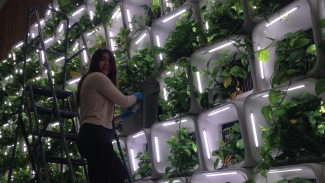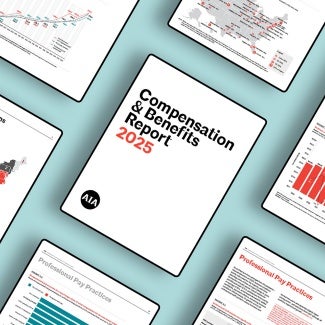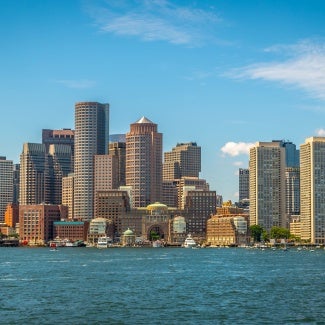Supporting transformational architectural practice
By Christina Ciardullo
The 2023-24 Future Forward grant recipient shares how support from AIA’s Young Architects Forum (YAF) and the Large Firm Roundtable (LRFT) provides the space to support innovation and creative new ways of practicing architecture. Learn about her research that evaluates vegetation in and on buildings.

I will never forget the professor who told me, “Architecture is the perfect merger of arts and sciences.” As an undergraduate philosophy and astronomy major deciding where to take my career, this sounded like a dream. As I began my professional career, there were moments in which the science of it all became increasingly important, especially in the context of an environmental crisis. Buildings account for 40% of global carbon emissions, they are the site and regulation of our consumption of water, energy, materials, and waste production. Our profession is called to design and build in harmony with the available resources of a finite world.
In encouraging client and design ambitions for socially responsible and sustainable architecture, it seems that if we are to live up to the claims made by our best intentions - biodiversity, fresh air, daylighting, social interconnectivity, metal health, and more - we would need to provide compelling and factual evidence to avoid the pitfalls of greenwashing. But within the parameters of current practice there is little time for the kind of research required to provide scientific data to clients. We rely on prior best practices, LEED, and other guidelines, and increasing numbers of consultants to help convey to our clients and the public that the lines on the page (or in the BIM model) are living up to the expectations of stakeholders from owner occupiers to perching birds. The practice of architecture needs access to scientific evidence at a rate it has not yet had the resources or scope to meet in business-as-usual professional settings. On the flip side, in the world or academia, there is not often the kind of holistic perspective and creative visioning that comes with the design professions who know the full physical and regulatory context in which new systems and tools reside. And while many offices are encouraging research groups, there is still some disconnect between research and practice in both time, budget, and skill set.
A game-changing grant
That is why the Future Forward Grant changed the game. The grant provides the space to support innovation and creative new ways of practicing architecture, securing a collaboration between academia and industry, helping to bridge the gap between scientific research and design in real time. In the spirit of testing ideas that disrupt the traditional conception of practice, the grant allowed me the opportunity and structure to explore that long-held notion that architects can be both artists and scientists in one.
There is perhaps no better example of the current disconnect between research and practice than images of buildings covered in vegetation - green facades, indoor and exterior living walls, and green roofs - often symbolizing sustainability without the data to support it. Even with many municipalities including cities like New York, San Francisco, Portland, Chicago, and Seattle, already providing incentives for these systems for their urban scale benefits, in nearly a decade of practice, I have yet to see a green wall survive Value Engineering.
With my grant, I am documenting the benefits and challenges of building-integrated vegetation in terms relevant for designers, building owners, developers, and occupants. I will be using evidence from scientific literature to quantify what impacts these installations can have on a building. Each living biomass system is highly dependent on design-specific elements, including the type of structure used, the choice of plant species and growing media. We need to be able to understand the relationship between these systems and their performance. Within the scientific literature there is evidence for vegetation systems to contribute to building operational carbon reductions, storm water management, urban biodiversity, air quality, and other tangible benefits to human and planetary health. Compared with conventional envelope materials, living walls and roofs provide comparable or improved energy savings from insulating and cooling effects and reduce urban heat island effect (in turn further reducing building’s cooling loads). And while the weight of soil and water in some system designs might contribute to additional embodied carbon of an increase in structure, this increase might be offset by further operational carbon savings on heating, cooling, ventilation, or reductions in the need for storm water infrastructure. This grant will help Architects understand how and how much impact vegetation can have on carbon across the whole building lifecycle.
My research will build on the long-term research of the Yale Center for Ecosystems and Architecture (cea.yale.edu) which has a long history of convening resources from both academia and industry, to tackle this value question. This grant will once again bring together academic research and practicing architects to tackle this question together to provide a set of design criteria for vegetation, and evaluation methods within project delivery to analyze their impact. We hope to arm architects with the data and information they require to make realistic decisions on the inclusion of a plant life in their building projects.
Apply for a 2024 Future Forward Grant
I am grateful to the Young Architects Forum and Large Firm Roundtable for supporting this test of research-led practice that remains true to the skill set of the profession. For all the many exemplary young professionals out there, who have imagined the evolution of the practice of architecture, the Future Forward Grant is a fantastic opportunity to convene partners and organize the space and time to test their ideas. With support from the AIA, young leaders will be able to demonstrate to their peers the potential for the future practice of architecture.
Learn more about the 2024 Future Forward Grant and apply.



